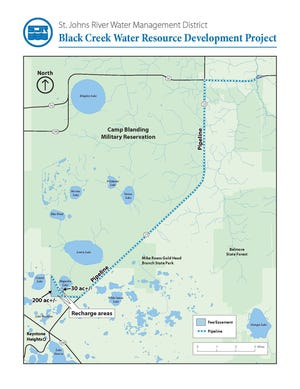
Comments by OSFR historian Jim Tatum.
jim.tatum@oursantaferiver.org
– A river is like a life: once taken,
it cannot be brought back © Jim Tatum
To pipe water to Keystone Heights, agency weighs plan to take color from Black Creek
State officials planning to pump water from dark Black Creek to Keystone Heights want to use filtering lessons from a sewage treatment plant to solve a water-color problem that held up work for two years.
The St. Johns River Water Management District’s governing board could vote Tuesday to approve a $1.2 million pilot project to filter water from the tannin-stained creek before constructing a pipeline to move creek water that would eventually reach Alligator Creek and naturally clear Lake Brooklyn.
Filtering the water wasn’t part of a $43 million budget that was drafted before Florida’s Legislature approved initial funding for a 10-million-gallon per day pipeline in 2017.
But it became an issue after the U.S. Environmental Protection Agency questioned whether introducing dark water would change the ecology of the lake, where dropping water levels have left lakefront homes with docks standing high and dry.
Pilot program could begin as soon as February
The pilot project, planned at a Clay County animal shelter off Florida 16 near Green Cove Springs, would be a real-world way to test plans to filter color out of the creek water, which would be collected just 750 feet away. The water management district owns land in that area intended to be the pipeline’s starting point.
The pilot would test how well color can be drawn out by running the water through a man-made wetland like one that went into operation last year at a Fleming Island sewage treatment plant to soak up phosphorus contributing to algae problems in Doctors Lake.
Some very small lab tests using SWIG’s trade-secret substance on creek water also removed about 85 percent of the color, apparently by filtering out bits of decayed plants that darken the water, a consultant told the water management district in October.
If the agency’s board approves, the pilot project – using thousands of gallons of water a day instead of millions – might begin operating as soon as late February, Seibold said.

The pilot could last a few months and provide information the agency will need to figure out how much room it will need to create color-filtering wetlands when the 17-mile pipeline is built.
The pipeline had been planned to collect water when the creek is relatively high and pump it to the southern end of the Florida National Guard’s Camp Blanding, to a spot that geologists say is a recharge area for the Floridan aquifer, the source of most of the drinking water in the state.
Although the pipeline was touted as a “water resource development” project that would help protect Northeast Florida’s water supply, actual work was delayed about two years while the water management district pursued a kind of waiver of rules about projects’ effects on water color. The agency withdrew its request for that waiver in October to try to get the project moving.
The man-made wetland, expected to last 20 years, was the cheapest of five color-removing alternatives a consultant detailed in a December report that estimated one option could cost $60 million.
If the plot project shows the wetland filtering delivers the needed results, it’s still not clear how the water management district will pay for the full-scale wetland.
Seibold said the agency might seek more state funding or might seek money from utilities who use the aquifer that the pipeline would help recharge.









Every time we try to fool mother nature we end up paying for it.